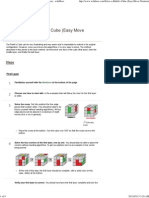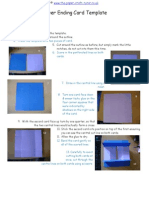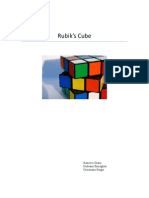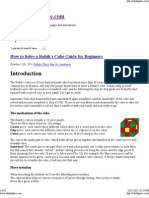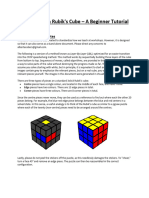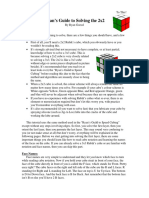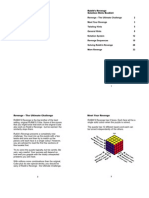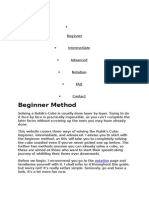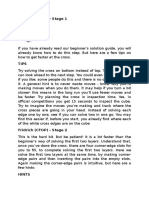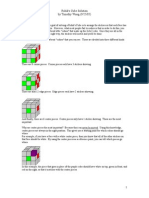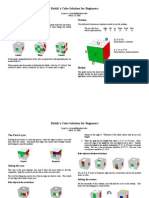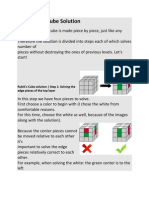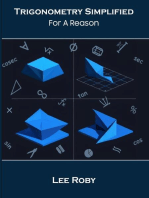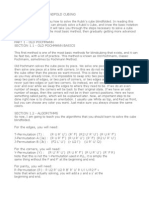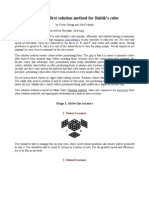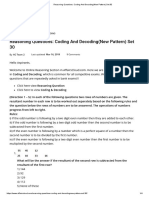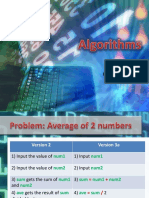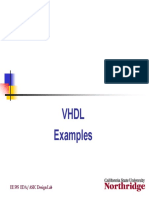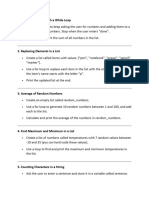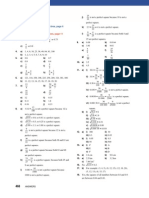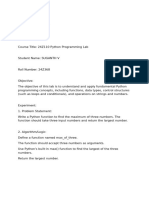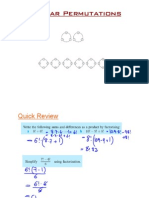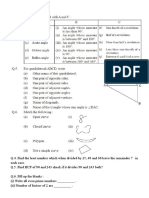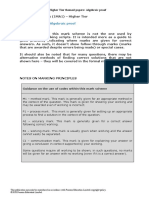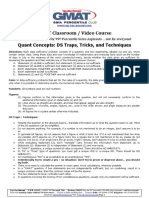Blindfold
Blindfold
Uploaded by
Vani MuthukrishnanCopyright:
Available Formats
Blindfold
Blindfold
Uploaded by
Vani MuthukrishnanOriginal Description:
Copyright
Available Formats
Share this document
Did you find this document useful?
Is this content inappropriate?
Copyright:
Available Formats
Blindfold
Blindfold
Uploaded by
Vani MuthukrishnanCopyright:
Available Formats
An Introduction to Blindfold 3x3x3 Rubiks Cube Solving Update: June 13, 2005 Version 1.
.0 This is an introductory tutorial for people wishing to solve a 3x3x3 Rubiks Cube while blindfolded. The ability to solve a 3x3x3 Rubiks Cube under normal conditions is a prerequisite. If you do not know how to solve a cube normally, please consult an introductory cube solution before attempting this blindfold tutorial. For further assistance, my e-mail is listed below. Introduction: This tutorial assumes that the reader already understands the basic concepts of cube notation and algorithms. The idea of solving a Rubiks Cube while blindfolded sounds intimidating, but with proper methods, the tasks is easily accomplished by anyone. For the blindfold solve, the solver memorizes the initial configuration of the cube. After the memorization is completed, the solver then proceeds to solve the cube without looking at it again. It is very difficult, and probably impossible by all but few, to actually keep track of all 20 stickers that shift when one turns a single face of the cube. Instead, the basic idea of blindfold solving is to solve the cube in very small portions, only two or three pieces at a time, thus reducing the need for continual updates of your mental picture. Setting Up The Cube: Unlike regular solving, blindfold solving is most easily done with the same center faces on top and in front at all times. The colors, as always, are arbitrary. World record holder, Leyan Lo, for example always solves with the yellow face on top and the blue face in front. Shotaro Makisumi, with his Japanese colorscheme cube, solves with the blue face on top and the green face in front. I personally solve with the white face on top and the green face in front. For this tutorial, I will explain how to solve the cube blindfolded while setting the white face on top and the green face in front while using a cube with the American color-scheme (white opposite of yellow). For many blindfold solvers, numbering the pieces is a good tool that assists in the memorization of the cube state. Numbers, like colors, are completely arbitrary. There is no difference between permuting corners (3, 5, 7) and permuting corners (llama, walrus, duck). Like the color orientation, go with whatever works for you. Orienting the Corners: First, we must orient all the pieces. This tutorial explains corner orientation before edge orientation. However, it should be noted that the order in which these processes are done is irrelevant. As long as the pieces are oriented before they are permuted, you will be fine. If it is more comfortable to orient the edges first, go ahead and do it that way.
The Idea: This method of blindfold solving takes place in two main steps. First, the pieces are all oriented. Then, the pieces are all permuted. Orientation is done first so that when the pieces are The idea is that we want to orient all the permuted into their proper locations, corners without affecting their placement they end up facing the right way. or any of the edges. In blindfold cubing, Tyson Mao World Cube Association tmao@worldcubeassociation.org http://www.its.caltech.edu/~tmao/blindfold.doc
An Introduction to Blindfold 3x3x3 Rubiks Cube Solving Update: June 13, 2005 Version 1.0 there are a variety of algorithms that one can use. The more algorithms one knows, the more options a solver has. This tutorial will present three methods of orienting corners. Now, we want to orient the corners in such a manner that when we apply the permutation algorithms, the end up in the correct orientation. Note that every corner will have a white or a yellow sticker. This should be fairly obvious: the cube consists of 8 corners. Four of the corners are on the top, and since our top color is white, four of them will have white stickers. Similarly, four of the corners are on the bottom, and since our bottom color is yellow, those four corners will have yellow stickers. Since white and yellow or opposite colors, no corner can have both a yellow and a white sticker. At the end of the orientation, we want all corners on the top layer to have white or yellow stickers facing up. On the bottom layer, we want all corners to have white or yellow stickers facing down. Scramble a cube, and notice that some of the corners are already correctly oriented they have yellow or white stickers facing directly up or down. Many of the corners will require a twist for this to happen. Not the same corners require clockwise twists, and other corners require counter-clockwise twists. bottom right corner is rotated clockwise, whereas the top right corner is rotated counter-clockwise. Now, perform the exact inverse of that algorithm: (R U2 R U R U R)(L U2 L U L U L). Youll notice that that algorithm solves the two twisted corners in the top layer. More specifically, the bottom right corner is twisted counterclockwise and the top right is twisted clockwise. Experiment with the mirror images of these algorithms. (R U R U R U2 R) (L U L U L U2 L) and (L U2 L U L U L) (R U2 R U R U R) should do similar things, but to the top left and bottom left corners in the top layer. Now, experiment with the following algorithm B2 (L U L U L U2 L)(R U R U R U2 R) B2. Youll notice that it twists the bottom right corner in the top layer clockwise and the top left corner in the bottom layer counter-clockwise. B2 is what we call a setup move. While orienting the cube, we can perform any setup moves necessary to position the pieces. First, perform the setup move. Then, perform the algorithm. Finally, reverse the setup move. Setup moves are used to bring other pieces into locations such that we may act on them with the algorithm. Experiment with a variety of setup moves, and gradually familiarize yourself with corner orientation.
With the provided algorithms and a On a solved cube, perform the algorithm couple of setup moves, you should be (L U L U L U2 L)(R U R U R U2 able to orient all the corners of the cube. R). Youll notice that the algorithm Make sure you familiarize yourself with twists two corners in the top layer. The Tyson Mao World Cube Association tmao@worldcubeassociation.org http://www.its.caltech.edu/~tmao/blindfold.doc
An Introduction to Blindfold 3x3x3 Rubiks Cube Solving Update: June 13, 2005 Version 1.0 the algorithms and that you understand exactly what they do. Try orienting all the corners of a scrambled cube. I will now explain another method of orienting corners. effect on the corners. The corner that was previously twisted clockwise is now twisted counter-clockwise and vice versa. Now attempt the algorithm R (D R D R D R) U2 R (D R D R D R) U2. You will notice that this algorithm is the same as the first, except there is a U2 move instead of a U. The effect is that it twists the diagonal corners instead. Notice how the U2 moves brings the diagonal corner into position and then the R move pushes it into the bottom layer. Now, try the following algorithm: R (D R D R D R D) U R (D R D R D R D) U R (D R D R D R D) U2 . First, notice that the portions of the algorithm in the parentheses are all identical. Next, notice that those portion are the same as the fundamental clockwise twist algorithms, but with an added D at the end. Now, notice that the first R pushes a corner into the bottom layer. The part in the parenthesis twists the corner clockwise. U R moves the next corner over and we also twist it clockwise. We repeat this a third time, and finally, U2 puts all the corners back in their original locations. The algorithm has twisted three corners all clockwise. Attempt the same thing, but substitute (D R D R D R D) into the algorithm to perform a counterclockwise three-cycle.
This method of orienting corners requires slightly more intuition, but is very powerful. Try the following algorithm on a solved cube: R (D R D R D R) U R (D R D R D R) U. Understanding exactly what this algorithm does is essential to its application. First of all, youll notice that this algorithm twists two corners in the top layer. The bottom right corner is twisted clockwise and the bottom left corner is twisted counter-clockwise. The mechanism of this algorithm is very powerful. The first R places the bottom right corner in the top layer into the bottom layer. The next part, (D R D R D R), twists the corner while creating some junk on the bottom layer as well. U R moves the bottom left corner in the top layer into the bottom layer and (D R D R D R) twists that corner counter-clockwise while reversing the junk on the bottom. U then reverses the U move which moved the corner over in the first place.
The fundamental moves in this corner orientation method are (D R D R D R) and (D R D R D R) . The first one For the advanced blindfold solver, performs clockwise twists while the algorithms such as [(R U R U)(R U2 second one performs counter-clockwise R U2)]x2, [(R U2 R U2)(R U R twists. Now, attempt the algorithm R U)]x2, and their inverses can be very (D R D R D R) U R (D R D R D powerful. Other multi-corner orientation R) U. You will notice that the sections algorithms exist as well but they should in parentheses are reversed, and so is the Tyson Mao World Cube Association tmao@worldcubeassociation.org http://www.its.caltech.edu/~tmao/blindfold.doc
An Introduction to Blindfold 3x3x3 Rubiks Cube Solving Update: June 13, 2005 Version 1.0 not be attempted until the solver is fully comfortable with the basic set of algorithms. With these tools and a combination of setup moves, you should now be able to orient all of the corners of the cube. Attempt to orient all the corners of the cube with your eyes open. Then, attempt to memorize the corner orientation of the cube and try to orient them blindfolded. Memorizing the corner orientation should not be too difficult, but if you need assistance, please see the next section. Now, all the corners should be oriented. Again, this means that only white or yellow stickers on the corners point directly up or down. Keep in mind that throughout this procedure, it is imperative that you are aware of the locations of your top and front sides. Memorizing: Everyone has his own memorization techniques. I will present the techniques that I use, but sometimes techniques that you develop on your own will ultimately be more powerful. Everyones mind works differently. Youll notice that I included two different methods of orienting the corners. I personally use both of them. Leyan and Macky only use the second one. Corner orientation is the last thing I memorize. I memorize the steps in reverse order of the actual solve. When you have adjacent pairs that need to be twisted clockwise and counterclockwise, there are two different shapes. In one of them, the two stickers of interest, in this case, yellow or white, will be on the same side. For other cases, theyll be facing away from each other. Sometimes, it is easier for me to remember what algorithm to apply rather than which way the piece wants to be twisted. Different methods of doing certain things on a blindfold solve act as tools. You can solve the cube with very few tools, but the more things you understand how to execute, the more ways you can do them, and the more choices you have. Sometimes, one choice will be more convenient than the other. Other memorization techniques that people do involve memorizing numbers for the corners. I personally do not do that, but it should be easy to see how this is done. Simply assign an ordering to the corners and then memorize the state of each corner. Memorizing the overall shape of the cube state can be a powerful tool. However, always remember that Im not right, and that you should experiment. Orienting the Edges: This step is very easy and many people consider this to be easier than orienting the corners. Leyan Lo performs this step first on the cube whereas Macky and I do this second after the corner orientation. Again, it doesnt matter which one you do first. The idea is that we are orienting the edges in such a manner that when we execute the edge permutation step, all of the edges are facing the correct way. Unlike permutation moves, setup moves during orientation have no restrictions. I will outline the restriction for permutation moves when we get there.
Tyson Mao World Cube Association tmao@worldcubeassociation.org http://www.its.caltech.edu/~tmao/blindfold.doc
An Introduction to Blindfold 3x3x3 Rubiks Cube Solving Update: June 13, 2005 Version 1.0 The most difficult thing of the edge orientation is recognizing which edges are oriented incorrectly. With edge orientations, we consider the top, bottom, front, and back colors. On my cube, white is my top, yellow is my bottom, green is my front, and blue is my back. Below are several criteria that indicate a correct edge. I will explain the logic for this later. If an edge is in the top player, it is correctly oriented if the top or bottom color is facing upwards. If the yellow or white sticker is facing upwards, then the edge is correct. This applies to the bottom layer as well. If the white or yellow sticker is facing directly downwards, the edge is oriented correctly. If the edge is in the top layer, it is correctly oriented if the green or blue sticker is facing off to the side. If a green or blue sticker is facing directly upwards, then it is incorrectly oriented. The same applies for the bottom layer. If the blue or green sticker is facing to the side, then it is correctly oriented. If the edge is in the middle layer, it is correctly oriented if the white or yellow sticker faces to the side. If the white or yellow sticker faces the front or the back, then it is incorrectly oriented. If the edge is in the middle layer, correctly oriented if the green or stickers faces the front or the back. incorrectly oriented if the green or sticker faces to the side. it is blue It is blue will be limiting ourselves to R2 and L2 double turn setup moves where as the U, D, F, and B faces are free to move however. For an edge with a white sticker in the middle layer, you will notice that if the white sticker faces to the side, we can bring it to the top layer and have the white sticker face directly up with one of the setup moves. However, if the white sticker faces in front, the setup moves that we are allowed to use will never be able to move the edge so that the white sticker is on top. The same logic is applied to all edges. Now, we will experiment with the algorithms. I use two main algorithms, but there are many edge orientation algorithms available, and as always, the more you know, the more choices you have. The main algorithm switches two opposite edges in the top layer. Perform the move (M U M U M U2)(M U M U M U2) on a solved cube. Youll notice that it switches the near and far edges in the top layer. M, for me, moves in the same direction as L. However, you should notice that M and M are interchangeable in this algorithm. It does not matter which way you move the middle slice first as long as you switch directions in the middle. Furthermore, the U can be easily substituted with a U. It does not matter; the algorithm is symmetric. I personally prefer U because I am right handed, and so I allow my right hand to perform the slice M move and my left index finger to do the U move.
Why are these the rules for orienting edges? When we permute edges, we
Now, try doing a setup move with this algorithm. Try the setup move L B, Tyson Mao World Cube Association tmao@worldcubeassociation.org http://www.its.caltech.edu/~tmao/blindfold.doc
An Introduction to Blindfold 3x3x3 Rubiks Cube Solving Update: June 13, 2005 Version 1.0 perform the algorithm, and then conclude with B L. Notice that L B moves the top left edge into the position formerly occupied by the top back edge. B L simply reverses the setup move. Try a variety of setup moves such as B2 or even a cube rotation. As long as you reverse your setup move, everything will be as you expect it. Now, try a four-edge flipper. The following algorithm will flip all four edges in the top layer. (M U M U M U M U)(M U M U M U M U) . Notice how it flips all four edges. Again, realize that M and M are interchangeable as with before. Furthermore, realize that I am right handed and that I prefer U over U. As with before, experiment with some setup moves and familiarize yourself with this algorithm. There are other algorithms available. Certain algorithms will flip six, eight, or even all twelve edges. However, I feel that these two algorithms are sufficient as almost all possible cube states can be reduced to just several applications of the above algorithms. Experiment with only the first half of the four-edge flipper and see what it does. Finally, experiment with this one: M2 U M U2 M U M U M U2 M U M . A list of algorithms will be provided at the end. of memorizing which edges need to be corrected, I will memorize the algorithms necessary to correct them. This is very fast as I can execute the algorithm without even thinking about the edges that Im affecting. Heres an example. Lets say I see three edges that need to be corrected on the top and one edge that needs to be corrected on the bottom. Instead of memorizing which edges are incorrectly flipped, I will memorize the setup move D R2 or something similar. Then, I will perform the setup move, apply the fouredge flipping algorithm, and then reverse the algorithm. There are many ways to memorize the cube, so by all means just do whatever works for you. Corner Permutation: All your edges should be oriented now. Now, we will put all the corners in their correct place. For this step, I have numbered my corners to assist in the recognition of the cycles. There is no standard numbering convention. Macky, Leyan, and I all do it differently.
Start with your first corner location. For me, this is the top, front, right corner. For Leyan, its the top, front, left, and he holds the world record, so maybe you should listen to him. If your first corner is correct, more specifically that the piece that belongs there actually is there, move on to your second corner. Memorizing: Again, if you prefer, one Otherwise, you will have a different can memorize the edge orientation state corner in that location. Look at the with numbers by simply ordering the corner in that location, and go to the numbers and then by remembering a position where that corner belongs. string a binary digits. I personally prefer Since that corner is in your first location, to just visualize where the incorrectly it cannot be where it belongs. Therefore, oriented edges are. Frequently, instead there will be another piece in that Tyson Mao World Cube Association tmao@worldcubeassociation.org http://www.its.caltech.edu/~tmao/blindfold.doc
An Introduction to Blindfold 3x3x3 Rubiks Cube Solving Update: June 13, 2005 Version 1.0 location. Look at where that corner wants to go, and go to the next corner position on the cube. Continue this until you find the corner that belongs in the first position, then stop. Thats a cycle. If you have accounted for all eight corners, then you are done. Otherwise, you will need to go to the next corner position that has not been visited by the previous cycle, and continue again. Lets make slot A our first corner position. Suppose corner B is in slot A. We then take a look at corner Bs desired position. In corner Bs position, we have corner C. We look at Cs position, and we see D. We look at Ds position, and then we see E. When we look at Es position, we see corner A, and so we stop, and we remember the cycle (ABCDE). It not necessary to memorize the cycles with letters or numbers. As long as you know where the cycle leads, its fine. Now, we continue on our memorization, and we go to the corner position F. We see that in corner position F is corner position G, and we follow G to H, which leads us back to F, and so we have the cycle (FGH). Occasionally, you will have cycles with an even number of elements such as (ABCD) or (EF) or (ABCDEFGH). If we have an even number of even cycles such as (AB), (CD), (EF), (GH), then there is no parity error. Otherwise, there is a parity error and I will discuss how to correct that later. First, we will deal with cycles of odd length. When we permute corners, we generally swap them three at a time. I will illustrate other algorithms later as well. Experiment with the algorithms (L F L B2 L F L B2 L2) and (R F R B2 R F R B2 R2). Notice that these two algorithms are mirror images and they both cycle three corners. Notice that (R F R B2 R F R B2 R2) cycles the bottom right corner to the top left position, the top left corner to the top right position, and the top right corner to the bottom right position all in the top layer. Even more importantly, notice that the bottom left corner in the top layer is untouched. Before we proceed, it is important to understand the restrictions of the setup moves. While permuting corners, only the U and D faces may make single turns. The F, L, B, and R faces are restricted to double turns. Consider now that we want to solve the cycle (ABCDE). First, we want to deal with the corners A, B, and C. The most common situation is that you have one corner in one layer, and two adjacent corners in the other layer. This is nice, because we can put all three corners in the top layer easily. Generally, this can be accomplished by a double turn of one of the side faces. Sometimes, a D2 is necessary to move the bottom corners away from the top corners. Notice, D and D are acceptable setup moves, but since D2 can solve every case, you might as well use it. It makes it easier to remember and you wont make a mistake going the wrong direction. Now that all three corners are in the top layer, determine whether or not they
Tyson Mao World Cube Association tmao@worldcubeassociation.org http://www.its.caltech.edu/~tmao/blindfold.doc
An Introduction to Blindfold 3x3x3 Rubiks Cube Solving Update: June 13, 2005 Version 1.0 wish to be cycled clockwise or counterclockwise and choose the appropriate algorithm. If they want to cycle clockwise, you need to do the right handed algorithm. Set up the three corners correctly. This is very easy if you remember the blank corner. One of the corners in the top layer does not need to be cycled. If we are doing the right handed algorithm, put this blank corner in the bottom left corner with a U, U, or U2 move. Then, do your algorithm, and reverse your setup moves. If it is a counter-clockwise cycle, then your blank corner goes in the bottom right corner. After you have cycled A, B, and C, you may eliminate B, and C from your string. Now, (ABCDE) becomes (ADE). Simple cycle (ADE) and you are done with that entire cycle. Do this until all corners are solved. Sometimes, you will have one corner in one layer, and you will have two corners situated diagonally from each other in the other layer. This makes the setup move more difficult. However, in my misunderstandings with Leyan, I have come up with a good way of solving these situations. Consider the cycle (ABC). A and B are in the to player. A is in the bottom right corner and B is in the top left corner. C is in the bottom layer directly below A. The idea here is that were going to swap two corners, then well swap the other two. In the process, the corners getting swapped diagonally will be swapped twice, and they will return to their original positions. Remember, we want to swap A to B, B to C, and C to A. Since C wants to go to A, we apply the algorithm right away. Now, we do U2, which positions B in the location where A used to be, we do the algorithm again, and weve swapped (ABC). Remember to do U2 again to undo your setup move. Because the corners in question are diagonal from each other, the setup moves in the middle of this algorithm are always double turns. Now, consider the same situation, but consider the cycle (BAC). Here, C wants to go to position B. Therefore, we must perform U2 first in order to place C in Bs position, and then we do U2 and swap the others. Notice that we do not need a U2 to reverse the setup move at the end. In this situation, we do not swap A and C first. A does want to go to C, but C is the lone corner, and if we swap A with C first, we will destroy it when we include the swap with B. The same method can be applied if two corners are diagonally in the bottom, and the other corner is in the top layer. Think about which position the top layer corner wants to go, and do that swap first. Then do D2, and do the next swap, and then reverse your setup moves.
Now, try to algorithm (R F R F)x3 where x3 means you repeat those moves three times. You will notice that corners A and C are swapped, B remains untouched, but the other two diagonal In this process, it is sometimes necessary corners in the top layer are swapped. Tyson Mao World Cube Association tmao@worldcubeassociation.org http://www.its.caltech.edu/~tmao/blindfold.doc
An Introduction to Blindfold 3x3x3 Rubiks Cube Solving Update: June 13, 2005 Version 1.0 to position the corners with U or D moves. Just make sure you reverse them when youre done. There are other similar algorithms such as (R B R B)x3. Theyre all basically the same. Now, we will discuss cycles of even length. How do we cycle (AB) and (CD)? Experiment with the algorithm (R F R B2 R F R B2 R2) U (L F L B2 L F L B2 L2) U. Notice you do not have to memorize anything new. Notice that this algorithm swaps the bottom left corner with the bottom right corner and the top left corner with the top right corner. However, sometimes it may be difficult to perform the necessary setup moves in order to place the corners in this configuration. Instead, we can swap the corners in two steps using a Tpermutation. This is very similar to Stefan Pochmanns blindfold method. Lets say we want to cycle (AB) and (CD). First, we will cycle A and B. Put A and B into the top right and bottom right corners in the to player. However, when doing these setup moves, we do not want to disturb the left and right edges in the top layer. This can be accomplished by performing a U or D move combined with a F2 or B2. Now, perform the algorithm (R U R U)(R F)(R2 U)(R U R U F). Now, you have successfully swapped corners A and B, but you have also swapped the left and right edges in the top layer. Reverse your setup moves, and now position C and D in the top right and bottom right corner positions, and do the algorithm again. You will swap C and D, and you will reverse the damage done to the edges. Note, that a U2 setup move will not damage your edges. Swapping the left and right edges is the same as the right and left. Sometimes, it is more convenient to swap the top right and bottom right corners, and then swap the top left and top right corners. This is also fine, but always keep in mind which edges are being swapped and be sure not to disturb them with your setup moves. If you do this, sometimes all four edges will be swapped. If this is the case, simply perform M2 U M2 U2 M2 U M2 and correct all four corners. Memorizing: Being the numerically minded person that I am, I generally rely on the use of numbers to aid in my memorization. It should be clear that if your corners are given numbers 1 to 8, you can generate a numerical cycle such as (1 5 7 2 4 3 8) which will give you all the information you need to complete the permutation of the corners. Numbers are especially useful if the permutation cycle resembles something mathematical such as (1 2 3 5 8)(4 6 7) where the first cycle consists of numbers from the Fibonacci sequence. However, numbers have generally become obsolete with the general blindfolding population and many people rely on the shapes and the patters of the permutation that the path of the corners trace out. Everyone has a different way of memorizing things and so pretty much as long as you can retain the information, it doesnt matter how you do it.
Tyson Mao World Cube Association tmao@worldcubeassociation.org http://www.its.caltech.edu/~tmao/blindfold.doc
An Introduction to Blindfold 3x3x3 Rubiks Cube Solving Update: June 13, 2005 Version 1.0 Edge Permutation: Permuting the edges is basically the exact same thing as permuting the corners. Instead, as stated above, the limitations of the setup moves are more liberal. We are allowed to make single turns on the F, B, U, and D faces. All setup moves on the left and right sides must be L2 and R2. The algorithms you will use will be the basic three-edge cycles. These should be quite familiar to you from speed cubing. Edge Parity Correction: In this tutorial, I have explained how to correct corner parity in the event you wish to switch corner A with B and corner C with D. Edge parity can be done very similarly. If you can situate your edges using the appropriate setup moves into an Hpermutation (M2 U M2 U2 M2 U M2) or Z-permutation (R B R B F R F B R B R F2 U), then those algorithms will correct the parity for you. Note: The Z-permutation can be performed on the F, B, U, and D faces and it will still maintain the orientation of the edges. The H-permutation can in fact be performed on any face. Try the H-permutation on the L face and notice is still preserves the orientation of your edges. Similarly, the H-permutation + U2 or (M2 U M2 U2 M2 U M2 U2) which swaps two sets of diagonal corners can also be performed on any face without interfering with the corner orientation. In general, corners that are being swapped diagonally may be swapped on any face. Otherwise, they are confined to U and D. Edges that are being swapped across and not adjacent may also be swapped on any face. Otherwise, they are confined to F, B, U, and D. Sometimes, it can be difficult to perform setup moves that arrange all four edges on the same face. In such cases, the parity can be broken down into two steps. Suppose you want to swap edges A and B and edges C and D. Using the setup moves with the appropriate limitations (double turns for the left and right sides), place edge A at the FU position and edge B and the BU position. Then, perform the H-permutation. Reverse your setup moves and then put edge C in the FU position and edge D in the BU position and perform another Hpermutation. Again, reverse your setup moves. This sequence first swaps edges A and B but also swaps edges at the FL and FR positions. The second Hpermutation swaps edges C and D while correcting the FL and FR edges. Corner and Edge Parity Correction: Corner and edge parity occurs when one wishes to swap corners A with B and edge C with D. If it is possible to bring A, B, C, and D all to the same face, then the appropriate PLL may be performed. It is important that if corners are being swapped non-diagonally and edges are being swapped adjacently, you probably have to perform the PLL on the U-face.
However, sometimes this can be difficult to setup, especially if you are blindfolded. It is possible to break down Tyson Mao World Cube Association tmao@worldcubeassociation.org http://www.its.caltech.edu/~tmao/blindfold.doc
An Introduction to Blindfold 3x3x3 Rubiks Cube Solving Update: June 13, 2005 Version 1.0 the corner/edge parity correction into two steps. First, let us correct the corners. We will be utilizing the T-permutation, which will swap the FRU corner with the BRU corner. Position corner A and corner B into FRU and BRU. In doing so, it is important not to disturb
Tyson Mao World Cube Association tmao@worldcubeassociation.org http://www.its.caltech.edu/~tmao/blindfold.doc
You might also like
- 8 Algorithms For Rubik's CubeDocument7 pages8 Algorithms For Rubik's Cubegagarin2013100% (3)
- How To Solve A Rubik's Cube, For Lazy PeopleDocument9 pagesHow To Solve A Rubik's Cube, For Lazy PeopleMichiel van der Blonk100% (129)
- Rubik's Cube (Easy Move Notation) - WikiHowDocument9 pagesRubik's Cube (Easy Move Notation) - WikiHowmoonerman100No ratings yet
- How To Solve A 3x3x3 Rubik's Cube For BEGINNERSDocument12 pagesHow To Solve A 3x3x3 Rubik's Cube For BEGINNERSSuresh ShresthaNo ratings yet
- Never Ending Card TemplateDocument2 pagesNever Ending Card TemplateVani MuthukrishnanNo ratings yet
- Instructions For Weaving A Complex Ojo de Dios, by Jay MohlerDocument17 pagesInstructions For Weaving A Complex Ojo de Dios, by Jay MohlerVani Muthukrishnan100% (1)
- Instructions For Weaving A Complex Ojo de Dios, by Jay MohlerDocument17 pagesInstructions For Weaving A Complex Ojo de Dios, by Jay MohlerVani Muthukrishnan100% (1)
- Billy Bob Tales Enid BlytonDocument142 pagesBilly Bob Tales Enid BlytonVani MuthukrishnanNo ratings yet
- TIMO - Sample Test - P2P3Document22 pagesTIMO - Sample Test - P2P3Hồng Sơn Nguyễn100% (2)
- Blindfold TysonMaoDocument10 pagesBlindfold TysonMaoapi-26839181No ratings yet
- Rubik's Cube: Ibanescu Diana Dudeanu Ermoghen Cracaoanu SergiuDocument28 pagesRubik's Cube: Ibanescu Diana Dudeanu Ermoghen Cracaoanu SergiuAna PuiuNo ratings yet
- How To Solve A Rubik's Cube (Easy Move Notation) : StepsDocument17 pagesHow To Solve A Rubik's Cube (Easy Move Notation) : StepsKarthik SathyaNo ratings yet
- Beginner Solution To The Rubik's CubeDocument7 pagesBeginner Solution To The Rubik's CubeHoang NguyenNo ratings yet
- How To Solve Rubik's Cube - CubeleloDocument15 pagesHow To Solve Rubik's Cube - CubelelovladmileaNo ratings yet
- BiksplaceDocument8 pagesBiksplaceSuvra PattanayakNo ratings yet
- Alberta Cubers Beginners InstructionsDocument6 pagesAlberta Cubers Beginners Instructionskher89alahNo ratings yet
- Jasmine Beingnners Rubiks Cube SolutionDocument8 pagesJasmine Beingnners Rubiks Cube SolutionjmcollantesNo ratings yet
- 7 Rubik's Cube Algorithms To Solve Common Tricky Situations - HobbyLarkDocument7 pages7 Rubik's Cube Algorithms To Solve Common Tricky Situations - HobbyLarkSitraka RNo ratings yet
- The 2x2 RubikDocument7 pagesThe 2x2 Rubikapi-281945496No ratings yet
- Rubiks Cube 2x2x2 Solving GuideDocument7 pagesRubiks Cube 2x2x2 Solving GuideKetut Joko WibawaNo ratings yet
- Ryan's Guide To Solving The 2x2: Face NamesDocument7 pagesRyan's Guide To Solving The 2x2: Face Namesmarc7victor7salesNo ratings yet
- Rubiks Cube 4x4x4 SolverDocument17 pagesRubiks Cube 4x4x4 Solvermazharjamdar100% (1)
- ©1974 Rubik. Rubik and Rubik's Are Trademarks of Seven Towns LTD., Used Under License. All Rights ReservedDocument20 pages©1974 Rubik. Rubik and Rubik's Are Trademarks of Seven Towns LTD., Used Under License. All Rights ReservedStefan MaximoviciNo ratings yet
- 5 Final CornersDocument13 pages5 Final Cornersapi-549171013No ratings yet
- Beginner's SolutionDocument8 pagesBeginner's SolutionMarcelo ManfredoNo ratings yet
- Rubik Beginner MethodDocument7 pagesRubik Beginner MethodRajat VermaNo ratings yet
- 4 X 4Document10 pages4 X 4Vani Muthukrishnan100% (1)
- RUBIK's CUBE BEGINNERS METHOD PDFDocument7 pagesRUBIK's CUBE BEGINNERS METHOD PDFShashank DixenaNo ratings yet
- Rubik's Cube (HAW)Document60 pagesRubik's Cube (HAW)htotisumNo ratings yet
- How To Solve A Rubik's CubeDocument8 pagesHow To Solve A Rubik's CubeVinay Kumar A SNo ratings yet
- RubiksCubeSolution DDRKirby (ISQ)Document10 pagesRubiksCubeSolution DDRKirby (ISQ)Alan ChuaNo ratings yet
- How To Solve A Rubik's Cube (Easy Move Notation) : Messages Log in Explore Help UsDocument16 pagesHow To Solve A Rubik's Cube (Easy Move Notation) : Messages Log in Explore Help UsAdithyaSBhatNo ratings yet
- How To Solve The Rubik CubeDocument8 pagesHow To Solve The Rubik CubeAnushka TulsyanNo ratings yet
- Beginner Method: NotationDocument12 pagesBeginner Method: NotationChimmiWangchukNo ratings yet
- Fridrich (CFOP) - Stage 1Document9 pagesFridrich (CFOP) - Stage 1Master CloneNo ratings yet
- Rubiks CubeDocument47 pagesRubiks CubeSoorya NarayananNo ratings yet
- How To Solve A Rubik's Cube, Step by Step - WIREDDocument18 pagesHow To Solve A Rubik's Cube, Step by Step - WIREDt_rajith1179No ratings yet
- Rubik's Cube Solution by Timothy Wong (9/25/05) : Structure of The CubeDocument10 pagesRubik's Cube Solution by Timothy Wong (9/25/05) : Structure of The CubeCrhistian David García MontoyaNo ratings yet
- How To Assemble A Rubix CubeDocument12 pagesHow To Assemble A Rubix Cubethiyagu_s03No ratings yet
- Tutorial Penyelesaian Rubik CubeDocument9 pagesTutorial Penyelesaian Rubik CubenazzserilNo ratings yet
- How To Solve A RubikDocument15 pagesHow To Solve A RubikJackie NguyenNo ratings yet
- Cube SolutionDocument4 pagesCube SolutionPrateek GoelNo ratings yet
- Rubiks Cube SolutionDocument5 pagesRubiks Cube SolutionBhooshan JapeNo ratings yet
- Beginners Method For Solving The 4x4 CubeDocument3 pagesBeginners Method For Solving The 4x4 CubeAung SittNo ratings yet
- Beginners Method For Solving The 4x4 CubeDocument3 pagesBeginners Method For Solving The 4x4 CubeEd DearNo ratings yet
- Rubik's Cube Solution - Step 1: Solving The Edge Pieces of The Top LayerDocument10 pagesRubik's Cube Solution - Step 1: Solving The Edge Pieces of The Top LayerArchish BabuNo ratings yet
- Based On "The Beginner's Solution To The Rubik's Cube" by Jasmine LeeDocument20 pagesBased On "The Beginner's Solution To The Rubik's Cube" by Jasmine Leerk_gprkavi2011100% (1)
- How To Solve A Rubik's Cube, Step by Step - WIREDDocument17 pagesHow To Solve A Rubik's Cube, Step by Step - WIREDAmv Bro100% (1)
- Sudoku-Beginner MethodDocument9 pagesSudoku-Beginner MethodKarishma MittalNo ratings yet
- Cube Solution 1Document10 pagesCube Solution 1Cassidy VarneyNo ratings yet
- 4 Ways To Solve A Rubik's Cube (Easy Move Notation) - WikiHowDocument14 pages4 Ways To Solve A Rubik's Cube (Easy Move Notation) - WikiHowBaguma Grace GariyoNo ratings yet
- CORNER TO CORNER CROCHET GUIDE: The essential C2C crochet guide to learn the skills and recent patterns to create stunning C2C projects from homeFrom EverandCORNER TO CORNER CROCHET GUIDE: The essential C2C crochet guide to learn the skills and recent patterns to create stunning C2C projects from homeNo ratings yet
- Origami Dots: Folding paper to explore geometryFrom EverandOrigami Dots: Folding paper to explore geometryRating: 5 out of 5 stars5/5 (1)
- Modular Origami Polyhedra: Revised and Enlarged EditionFrom EverandModular Origami Polyhedra: Revised and Enlarged EditionRating: 4 out of 5 stars4/5 (4)
- Bob Burton Pyraminx MethodDocument3 pagesBob Burton Pyraminx MethodVani MuthukrishnanNo ratings yet
- The Factories Act, 1948: Ranjeet Kumar YadavDocument92 pagesThe Factories Act, 1948: Ranjeet Kumar YadavVani Muthukrishnan0% (1)
- 4 X 4Document10 pages4 X 4Vani Muthukrishnan100% (1)
- A6 Pyramage TemplatesDocument1 pageA6 Pyramage TemplatesVani MuthukrishnanNo ratings yet
- 7 The Mystery of The Fiery EyeDocument24 pages7 The Mystery of The Fiery EyeVani MuthukrishnanNo ratings yet
- Adventure 1 - The Island of AdventureDocument77 pagesAdventure 1 - The Island of AdventureVani MuthukrishnanNo ratings yet
- How Can I Solve A 2x2x2 RubikDocument1 pageHow Can I Solve A 2x2x2 RubikVani MuthukrishnanNo ratings yet
- Blindfold Cube SolvingDocument9 pagesBlindfold Cube SolvingVani MuthukrishnanNo ratings yet
- Corners-First Solution MethodDocument7 pagesCorners-First Solution MethodVani MuthukrishnanNo ratings yet
- 100 Questions On Logical Puzzles by Dinesh Miglani Online Test GuruDocument11 pages100 Questions On Logical Puzzles by Dinesh Miglani Online Test Gururohitsatija9No ratings yet
- Reasoning Questions - Coding and Decoding (New Pattern) Set 30Document4 pagesReasoning Questions - Coding and Decoding (New Pattern) Set 30saurabh sumanNo ratings yet
- Lotus Academy: Gate Tutorial: General AptitudeDocument32 pagesLotus Academy: Gate Tutorial: General AptitudeTanishq AwasthiNo ratings yet
- 01b - Algorithms (Flowcharts)Document27 pages01b - Algorithms (Flowcharts)Floyd VillamorNo ratings yet
- Module 1 Applied Linear EquationsDocument62 pagesModule 1 Applied Linear EquationsCj CaraigNo ratings yet
- VHDL Examples: EE 595 EDA / ASIC Design LabDocument55 pagesVHDL Examples: EE 595 EDA / ASIC Design Labsaketh rNo ratings yet
- Basic Python Coding Questions IGCSE Grade 9Document3 pagesBasic Python Coding Questions IGCSE Grade 9HardikNo ratings yet
- Math LPDocument8 pagesMath LPmikka lobatonNo ratings yet
- Math DLPDocument9 pagesMath DLPPearl DiansonNo ratings yet
- Number Theory - BrilliantDocument4 pagesNumber Theory - BrilliantPikachuNo ratings yet
- mms9 EndmatterDocument87 pagesmms9 Endmatterapi-265180883No ratings yet
- Permutations and CombinationsDocument4 pagesPermutations and CombinationsSyed NazmiNo ratings yet
- GRE 2. OG 150 Barron Magoosh 3. 4. 1.0 5. GRE All in One GREDocument59 pagesGRE 2. OG 150 Barron Magoosh 3. 4. 1.0 5. GRE All in One GREAnnabelle GuanNo ratings yet
- South African Mathematics FoundationDocument7 pagesSouth African Mathematics FoundationichkhuyNo ratings yet
- Hamming Code in Computer NetworkDocument5 pagesHamming Code in Computer Networkshashi bhushanNo ratings yet
- Phil Goldstein - Amperthand - Lisp Series Part 3Document14 pagesPhil Goldstein - Amperthand - Lisp Series Part 3Mario Langlois100% (1)
- Buffet Contest + Solutions - X - Canada 2009Document6 pagesBuffet Contest + Solutions - X - Canada 2009Richa SrivastavaNo ratings yet
- 1-x1, x2, x3 Mental Ability Package Phase I (09.04.20) AdtDocument68 pages1-x1, x2, x3 Mental Ability Package Phase I (09.04.20) AdthappyNo ratings yet
- Python Lab Report toDocument40 pagesPython Lab Report tosuganthr09No ratings yet
- GMAT Flashcards v5Document121 pagesGMAT Flashcards v5Toyin LadipoNo ratings yet
- Solved CAT 2007 Paper With SolutionsDocument46 pagesSolved CAT 2007 Paper With SolutionsAkanksha DeyNo ratings yet
- A Corner of Mathematical Olympiad and Competition Book V: (Selection Problems From Europe)Document634 pagesA Corner of Mathematical Olympiad and Competition Book V: (Selection Problems From Europe)Ruan Qinglong100% (1)
- Sample Prob PermutationsDocument16 pagesSample Prob PermutationsJoyjoy C LbanezNo ratings yet
- ProgramsDocument5 pagesProgramsBharathiNo ratings yet
- Solutions To Part I of Game TheoryDocument16 pagesSolutions To Part I of Game TheoryMiguel FranciscoNo ratings yet
- J1 Solutions LatexDocument6 pagesJ1 Solutions LatexBobNo ratings yet
- Test 1 To 5 MathDocument2 pagesTest 1 To 5 MathRavi KumarNo ratings yet
- 02b Algebraic Proof - H - Mark Scheme v2Document6 pages02b Algebraic Proof - H - Mark Scheme v2AbhinNo ratings yet
- Quant 0 DS TrapsDocument3 pagesQuant 0 DS TrapsSandeep GuptaNo ratings yet


